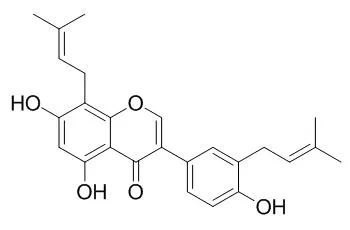| In vitro: |
| J Asian Nat Prod Res. 2017 May;19(5):510-518. | | Prenylated isoflavones from Cudrania tricuspidata inhibit NO production in RAW 264.7 macrophages and suppress HL-60 cells proliferation.[Pubmed: 27649772] |
METHODS AND RESULTS:
Inhibitory effects of NO production in RAW 264.7 macrophages guided the isolation of nine prenylated isoflavones, including a new cudraisoflavone L (1) and eight known metabolites furowanin B (2), erysubin A (3), wighteone (4), lupalbigenin (5), laburnetin (6), Isolupalbigenin (7), 6,8-diprenylorobol (8), millewanin H (9) from the leaves of Cudrania tricuspidata.
CONCLUSIONS:
At the concentration of 10 μM, compounds 1, 2, and 4 significantly inhibited NO production with the inhibitory values of 72.5 ± 2.4, 66.9 ± 1.8, and 55.4 ± 2.7%, respectively. In addition, all of isolated compounds 1-9 showed promising cytotoxic effects toward HL-60 cells (IC50 4.3 ± 0.7 to 18.0 ± 1.7 μM). | | Lett Appl Microbiol. 2006 Sep;43(3):243-8. | | Different antibacterial actions of isoflavones isolated from Erythrina poeppigiana against methicillin-resistant Staphylococcus aureus.[Pubmed: 16910926 ] | To screen six isoflavones isolated from Erythrina poeppigiana (Leguminosae) for their antibacterial activity against methicillin-resistant Staphylococcus aureus (MRSA).
METHODS AND RESULTS:
Stem bark of E. poeppigiana was macerated with acetone and the methylene chloride-soluble fraction of the residue was applied to repeated silica gel column chromatography and eluted. Minimum inhibitory concentration (MIC) and minimum bactericidal concentration (MBC) were determined by a broth dilution method. Inactive compounds that failed inhibiting bacterial growth at 25 microg ml(-1) were further investigated for their combination effects with methicillin and oxacillin. Of the isolated isoflavones, 5,7,4'-trihydroxy-8,3'-di(gamma,gamma-dimethylallyl)isoflavone (Isolupalbigenin) exhibited the highest anti-MRSA activity (MICs: 1.56-3.13 microg ml(-1); MBCs: 6.25-12.5 microg ml(-1)), followed by 5,7,4'-trihydroxy-6-gamma,gamma-dimethylallylisoflavone (erythrinin B). Inactive compounds were combined with methicillin or oxacillin, 5,4'-dihydroxy-(3'',4''-dihydro-3''-hydroxy)-2'',2''-dimethylpyrano[5'',6'':6,7]isoflavone (M-Wi-2) intensifying the susceptibility of MRSA strains to these antibiotics. In all but one strain, the MIC values of methicillin were reduced from > or =100 to 6.25-12.5 microg ml(-1) in the presence of M-Wi-2 (25 microg ml(-1)).
CONCLUSIONS:
Isoflavones from E. poeppigiana showed two different antibacterial activities against MRSA: direct growth inhibition and intensification of methicillin sensitivity. Isolupalbigenin and M-Wi-2 could lead to the development of compounds for new approaches against MRSA infection. |
|






 Cell. 2018 Jan 11;172(1-2):249-261.e12. doi: 10.1016/j.cell.2017.12.019.IF=36.216(2019)
Cell. 2018 Jan 11;172(1-2):249-261.e12. doi: 10.1016/j.cell.2017.12.019.IF=36.216(2019) Cell Metab. 2020 Mar 3;31(3):534-548.e5. doi: 10.1016/j.cmet.2020.01.002.IF=22.415(2019)
Cell Metab. 2020 Mar 3;31(3):534-548.e5. doi: 10.1016/j.cmet.2020.01.002.IF=22.415(2019) Mol Cell. 2017 Nov 16;68(4):673-685.e6. doi: 10.1016/j.molcel.2017.10.022.IF=14.548(2019)
Mol Cell. 2017 Nov 16;68(4):673-685.e6. doi: 10.1016/j.molcel.2017.10.022.IF=14.548(2019)